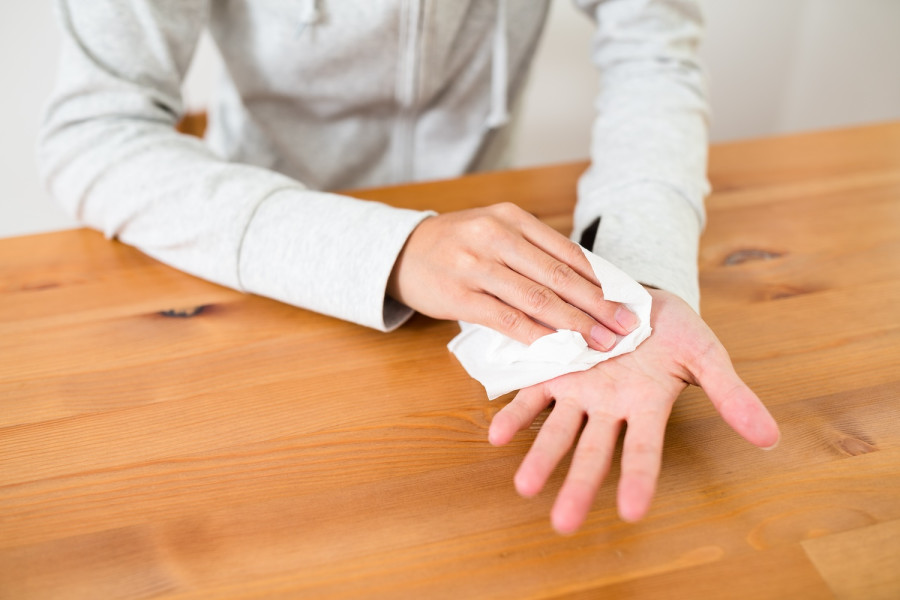Culture & Lifestyle
Palmar Hyperhidrosis: Coping with excessive palm sweating
Dermatologist Anupama Karki discusses the causes, symptoms, treatment options, and lifestyle adjustments needed to manage this challenging condition.
Post Report
Dermatologist Anupama Karki discusses the causes, symptoms, treatment options, and lifestyle adjustments needed to manage palmar hyperhidrosis.

What is palmar hyperhidrosis, and what are its causes?
Palmar hyperhidrosis is a medical condition characterised by excessive, uncontrollable, and unpredictable palm sweating. This problem is stressful and confidence-wrecking.
It is a benign condition with no clear cause. Some of the causes can be genetics, medical conditions such as hyperthyroidism, diabetes mellitus, nervous system disorders, infections, perimenopausal, stress and anxiety.
Sometimes, hormones and hyperactive sweat glands can also cause excessive sweating.
What are the common symptoms of palmar hyperhidrosis?
The most common symptoms include profuse sweating from both palms and feet, which might also be from the axilla, even at normal temperature or at rest.
Sweating might be visible, and the skin might be clammy. Some might find it difficult to do daily activities like gripping objects, writing, or using devices. Lastly, stress and anxiety also cause sweating.
What are the treatment options for managing palmar hyperhidrosis?
It is difficult to completely eliminate this condition. However, one must consult a dermatologist and run necessary blood tests. Some of the available treatments are topical antiperspirants.
Iontophoresis is a procedure in which a mild electric current is passed through water to temporarily disable sweat glands. Regular sessions are needed for quite some time to maintain results.
Botulinum toxin injections are another modality of treatment. They block the nerve that stimulates the sweat glands. This treatment is costly as it needs to be repeated every six months.
Anticholinergic medicines like Glycopyrrolate and Oxybutin can reduce sweating by blocking the action of the neurotransmitter Acetylcholine, which is involved in sweating. This might not be suitable for everyone.
Sympathectomy is a surgical procedure and the last option to consider. In this procedure, nerves involved in sweating are surgically removed. This might result in side effects like compensatory sweating.
Anxiety and stress management, along with counselling, can be beneficial.
Are there any lifestyle changes or home remedies that can help manage the symptoms of this condition?
Understanding the condition and managing stress and anxiety can help reduce sweating episodes. Staying in a cool environment and wearing comfortable, thin clothes can help reduce the symptoms.
It is advisable to carry a tissue or a powder to wipe the excessive sweat. Drinking sage tea can also help. Lastly, limiting the consumption of spicy food and salt can help eliminate the symptoms of the condition.
How can people differentiate between palmar hyperhidrosis and normal sweating?
Medically speaking, Palmar hyperhidrosis differs from normal sweating. Palmar hyperhidrosis is localised. It is excessive and uncontrolled sweating from palms spontaneously without any clear initiating factors. It is persistent and lasts for longer periods. This might be genetics.
Normal hyperhidrosis (sweating) occurs in larger areas of the body, including the soles, axilla, and chest. It usually occurs in response to heat, physical exercise, or triggering factors. This condition is not genetic.
What can individuals with the condition do to manage their condition in the long term?
Patients must know and understand this condition and make lifestyle changes accordingly. Consulting a dermatologist and making an accurate diagnosis can help alleviate the symptoms.
Stress and anxiety management, meditation, yoga, and maintaining personal hygiene can ease the condition in the long term.
How can individuals cope with the anxiety associated with excessive sweating?
Coping with embarrassment and anxiety involves a combination of practical strategies, medical interventions and psychological approaches. Stress management techniques such as yoga, meditation, deep breathing exercises can be beneficial, along with these:
Open communication: Talk to your close friends, family, and colleagues.
Educate yourself: Learn about the condition and understand that it is a medical issue which you have no control over.
Therapy and counselling: Speaking to your therapist or counsellor can help you manage anxiety and embarrassment, particularly with cognitive behavioural therapy.
Join support groups: This will make you feel like you are not alone, and you can also share your experiences.
Practical solutions: Carry supplies like towels, handkerchiefs, and absorbent
wipes. Use antiperspirants and absorbent powders.
Positive self-talk: Focus on your strengths and accomplishments rather than sweating.
Seek professional help: Whenever you feel it is required.




 13.12°C Kathmandu
13.12°C Kathmandu














